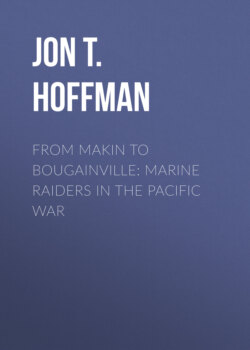Читать книгу From Makin to Bougainville: Marine Raiders in the Pacific War - Jon T. Hoffman - Страница 8
На сайте Литреса книга снята с продажи.
Оглавление[Sidebar (page 4):]
Destroyer Transports
Table of Contents
The origins of the destroyer transports are relatively obscure. The first mention of them came in the 1st Marine Brigade’s after action report on Fleet Landing Exercise 3 (FLEX 3). Brigadier General James J. Meade suggested in that February 1937 document that destroyers might solve the dual problem of a shortage of amphibious transports and fire support. With such ships “troops could move quickly close into shore and disembark under protection of the ships’ guns.” The Navy apparently agreed and decided to experiment with one of its flush-deck, four-stack destroyers. It had built a large number of these during World War I and most were now in mothballs.
In November 1938 the Navy reclassified Manley (DD 74) as a miscellaneous auxiliary (AG 28). After a few weeks of hasty work in the New York Navy Yard, the ship served as a transport for Marine units in the Caribbean. In the fall of 1939 Manley went back into the yards for a more extensive conversion. Workers removed all torpedo tubes, one gun, two boilers, and their stacks. That created a hold amidships for cargo and troops. The Chief of Naval Operations made it a rush job so the ship would be available for FLEX 6 in early 1940. Company A, 1st Battalion, 5th Marines, was the first unit to use the revamped Manley. It used rubber boats to execute its 23 February 1940 assault landing against Culebra in the Caribbean.
Satisfied by the utility of the destroyer transport, the Navy redesignated Manley yet again, this time as the lead ship of a new class, APD-1. The APD designation denoted a highspeed transport. By the end of 1940 the Navy yards had reactivated five of Manley’s sister ships and converted them in the same fashion. In its haste, the Navy had left out any semblance of amenities for embarked Marines. When Lieutenant Colonel Edson took his battalion on board the APD squadron in the summer of 1941, each troop compartment was nothing more than an empty space—no ventilation, no bunks, and just four washbasins for 130 men. It took a high-level investigation, launched by one Marine’s letter to his congressman, to get the billeting spaces upgraded.
These original six APDs would be the only ones available until the Navy rushed to complete more in the aftermath of Pearl Harbor. As the two raider battalions moved out into the Pacific, so did the APDs. All six ships saw service in the Solomons campaign, but only Manley and Stringham (APD 6) survived. Japanese bombers sank Colhoun (APD 2) on 30 August 1942, just after it had transferred a company of the 1st Raiders from Tulagi to Guadalcanal. Enemy destroyers sank Gregory (APD 3) and Little (APD 4) in the early morning hours of 5 September 1942 after the two transports had participated with the 1st Raiders in a reconnaissance of Savo Island. A torpedo bomber ended the existence of McKean (APD 5) on 17 November 1943 as she ferried troops to Bougainville. Before the war was over, the Navy would convert another 133 destroyers and destroyer escorts to the transport role.
